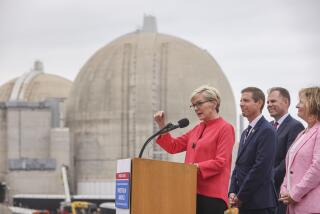U.S. Plans Two Ways to Get Rid of Plutonium
- Share via
WASHINGTON — In a decision certain to create controversy, the Energy Department will announce today that it plans to use two interim methods to dispose of 50 tons of surplus nuclear weapon plutonium: burning it in nuclear reactors, and encasing it in glass and burying it underground, according to a Clinton administration official.
The Energy Department plan is to try both methods for two years to determine which will be cheaper and more effective at making the plutonium least vulnerable to reuse in weapons and least harmful to the environment. The Energy Department will then decide whether to eliminate one approach or continue with both.
Plutonium, a man-made element created in the Manhattan Project during World War II, is used in nuclear bombs to initiate an atomic fission reaction that triggers a far more powerful fusion blast. It can also be burned in some nuclear reactors to produce energy.
The surplus fuel comes from existing nuclear weapons and from stockpiles that had been destined for weapons use. The United States stopped making nuclear weapons in the early 1990s in response to disarmament treaties with the former Soviet Union. Even after these 50 tons of plutonium are destroyed, about 49 tons will remain in about 6,000 U.S. nuclear weapons that will still be allowed by current arms limitation treaties.
*
Russia is continuing to produce weapons-grade plutonium, despite efforts by the Bush and Clinton administrations to negotiate an agreement to end those operations. Energy Department critics say an agreement with Russia will now be even harder to reach.
The decision even to consider burning the plutonium in reactors has evoked a bitter outcry from environmentalists and arms control advocates, who fear that it will be interpreted internationally as a U.S. endorsement of commercial use of plutonium.
The formal decision today will be subject to a 30-day public comment period. Then Energy Secretary Hazel O’Leary can make a decision to go ahead with the dual-track plan.
A decision on which technology to adopt will not be made by O’Leary because she is leaving the Clinton administration.
Although the decision is one that will carry significance for thousands of years, some experts said they were deeply disappointed that the United States is delaying a final decision.
“A decision on plutonium is long overdue,” said Arjun Makhijani, president of the Institute for Energy and Environmental Research in Washington. “The U.S. energy industry is still dreaming of using plutonium as an energy source.”
Clinton administration officials said the decision had nothing to do with commercial use of plutonium. Indeed, the cost of putting the plutonium in a form that could be burned in a reactor, so-called mixed oxide fuel, would cost more than the energy value of the plutonium.
An Energy Department official said the agency has estimated that it will cost $2 billion over 20 years to dispose of the plutonium by burning it in a reactor and using the energy commercially.
By comparison, vitrifying the plutonium in glass or ceramics and storing it underground would cost $1.8 billion.
A combination of the two technologies, which the U.S. may ultimately have to adopt, could cost $2.2 billion.
The reason that the U.S. may dispose of plutonium with two technologies, experts say, is that about one-third of the surplus is in the form of mixed waste, which may be difficult, or even impossible, to purify for use as a reactor fuel.
The Energy Department considered 30 alternative technologies to get rid of the surplus plutonium and narrowed the field to three final options. In addition to burning it in reactors or encasing it and burying it, the department considered putting the plutonium at the bottom of a 2-mile-deep hole with a diameter of a few feet.
*
Although that idea was the cheapest, costing about $1.5 billion, the department has been dealing with two other massive programs to create repositories for other nuclear wastes. The idea of another dump would have generated more controversy.
“We have gone from 30 different approaches to two, and that shows a lot of progress,” an Energy Department official said. “We want to know what kinds of costs we are getting into with these technologies.”
The U.S. made about 99 tons of plutonium during five decades after World War II. The Clinton administration had determined that the 50 tons to be destroyed is surplus and that the remaining 49 tons would be held in a strategic reserve.
More to Read
Sign up for Essential California
The most important California stories and recommendations in your inbox every morning.
You may occasionally receive promotional content from the Los Angeles Times.











